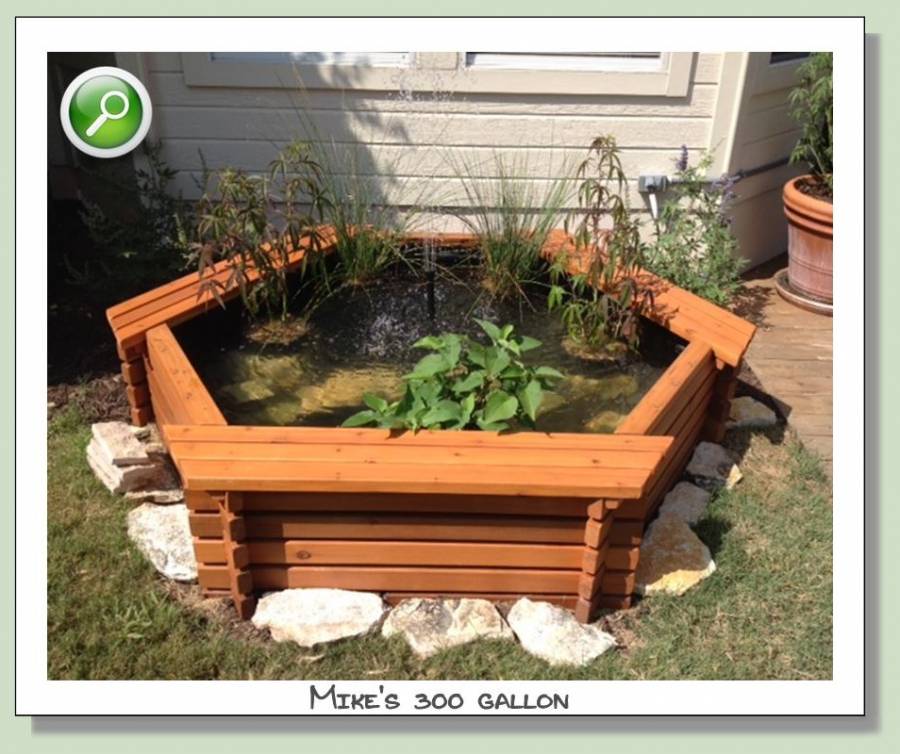Aquatic Gardening
The practice of gardening in water has records back to 5000 B.C. Paintings from the times of the Ancient Egyptians and Pharaohs show palace gardens filled with water lilies, lotus and other aquatic plants.
ARE THERE ADVANTAGES TO ADDING PLANTS TO MY POND?
Gardening with water plants can be a whole new world to even the most practiced gardener. Essentially one creates micro worlds full of flora and fauna. The general practice of understanding the balance of flora and fauna will result in a magnificent, low maintenance water garden.
Aquatic plants are an integral part of a garden pond. They not only give your pond a natural, beautiful look, but have numerous other benefits.
Advantages of using aquatic plants:
- plants absorb ammonium, nitrates, phosphates and some metals, helping to improve water quality.
- Plants supply shelter and food for your fish.
- Aquatic plants help reduce algae by competing with the intake of essential nutrients and shading the pond.
- They help keep a biological balance.
- By shading the water, plants help prevent the water from overheating.
Plants provide a natural form of filtration and help oxygenate the pond. They play an essential roll in maintaining stable water conditions. Floating, submerged and marginal plants can bring an ecological balance to a pond. A proper selection of complementary plants can help you achieve a healthy pond environment. A general ratio, depending on how much sun the pond gets, is:
50% - 70% surface coverage and one bunch of oxygenators for every 2 square feet of open surface area. With this balance of plants and a moderate fish load, one can achieve clear water without the addition of filters.
WHAT KIND OF PLANTS WILL WORK BEST IN MY POND?
There are four types of aquatic pond plants. They include deep-water, marginals (also called bog plants), floating plants, and oxygenating plants.
Deep-water aquatic plants like water lilies, take root in the bottom of the pond. They do not like flowing water.
DEEP WATER PLANTS
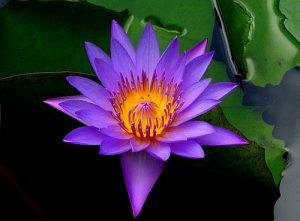
Hardy Water Lilies are ideal for any water garden because of their perennial beauty, ease of culture, wealth of bloom, and range of color and form. They grow readily when provided with sunlight, rich soil, warm water, and are exceptionally hardy. Their purchase may be considered a permanent investment, with reasonable care they can be retained for many years.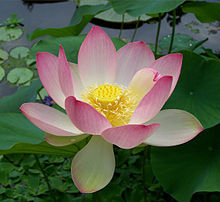 Water Lotus are hardy perennials considered sacred in Buddhist's beliefs. This group of water garden plants are sold as tubers and the smaller varieties have leaves and flowers as small as 2 - 3". They require a sunny location and a little more care than water lilies, but the results are a spectacular plant that returns year after year.
Water Lotus are hardy perennials considered sacred in Buddhist's beliefs. This group of water garden plants are sold as tubers and the smaller varieties have leaves and flowers as small as 2 - 3". They require a sunny location and a little more care than water lilies, but the results are a spectacular plant that returns year after year.
Marginal plants, also called bog plants, live in three to six inches of water and are the most common plants in a pond. You can place the potted plants on top of bricks or up-side-down plant pots to get them to the correct depth.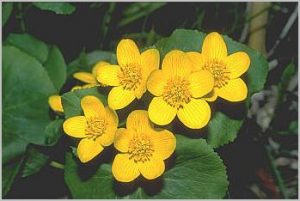
Marsh Marigolds are one of the most popular marginal plants. It has heart shaped leaves with Buttercup type flowers, which bloom in April. They prefer to be in a bog setting, but can be placed in the pond as long as there isn't much water above the crown of the plant. This plant prefers part shade to full sun. This plant will bloom in the spring and fall.
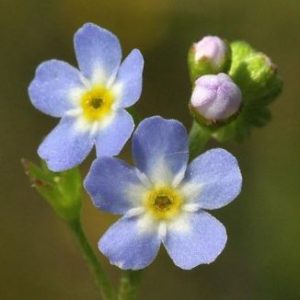
The Water Forget-me-not is a highly recommended species for any pond. It is a lovely, untidy sprawling plant, with small sky blue (occasionally pink or white) flowers, that can creep over pond edges. It is a reliable and easy to grow marginal that prefers to be planted in full sun. It will grow about 6 – 9 inches in height.
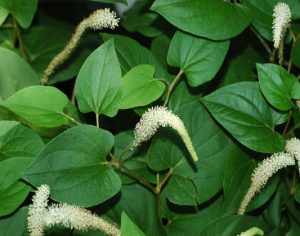 Lizard's Tail has bright green heart shaped leaves with a display of an unusual catkin flower head creamy white in color with a slight fragrance. Flower heads usually appear during June and August. The plant height is between 1 - 2 feet. It likes to be planted in full sun to part shade in the bog or shallow water. This plant is lush and is a great addition to any pond.
Lizard's Tail has bright green heart shaped leaves with a display of an unusual catkin flower head creamy white in color with a slight fragrance. Flower heads usually appear during June and August. The plant height is between 1 - 2 feet. It likes to be planted in full sun to part shade in the bog or shallow water. This plant is lush and is a great addition to any pond.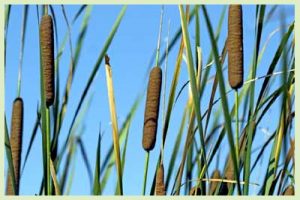 The Dwarf Cattail is a smaller version of the common cattail and makes an excellent background plant. They are great for smaller ponds as well as tub and container gardening. The foliage is very narrow and grass-like in appearance and small, round, dark brown flower spikes add to its charm. This plant will grow to a height of between 12 to 36".
The Dwarf Cattail is a smaller version of the common cattail and makes an excellent background plant. They are great for smaller ponds as well as tub and container gardening. The foliage is very narrow and grass-like in appearance and small, round, dark brown flower spikes add to its charm. This plant will grow to a height of between 12 to 36". Aquatic Iris are available in many varieties, sizes and colors, including blue, purple, yellow, white, red and orange - or even a mixture of colors. Blossoms are at the end of tall stocks that lift the flower above the leaves. All bloom in spring to early summer. Grow in full sun to part shade. All have exceptionally beautiful blossoms.
Aquatic Iris are available in many varieties, sizes and colors, including blue, purple, yellow, white, red and orange - or even a mixture of colors. Blossoms are at the end of tall stocks that lift the flower above the leaves. All bloom in spring to early summer. Grow in full sun to part shade. All have exceptionally beautiful blossoms.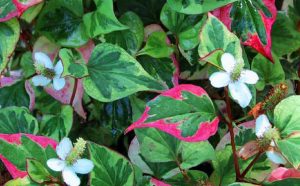 The Chameleon is a great foliage plant that grows 8 - 12" tall. It has heart shaped leaves of blue-green with yellow and red variegation. It blooms from May through August with white white flowers with yellow centers. This plant requires full sun to partial shade. You may want to confine this aggressive grower to a container.
The Chameleon is a great foliage plant that grows 8 - 12" tall. It has heart shaped leaves of blue-green with yellow and red variegation. It blooms from May through August with white white flowers with yellow centers. This plant requires full sun to partial shade. You may want to confine this aggressive grower to a container.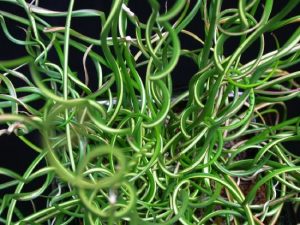 The Corkscrew Rush is one of my favourites because of the way the stems grow in a corkscrew fashion. The light green flowers are insignificant, as they are very small and sometimes missed when the plant blooms. The plant grows in a "mound" and it is a wonderful specimen plant. It prefers full sun, but will tolerate part shade.
The Corkscrew Rush is one of my favourites because of the way the stems grow in a corkscrew fashion. The light green flowers are insignificant, as they are very small and sometimes missed when the plant blooms. The plant grows in a "mound" and it is a wonderful specimen plant. It prefers full sun, but will tolerate part shade.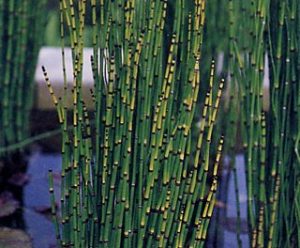
The Micro-Mini Horsetail grows approx. 10" tall. Horsetail is an ancient, unusual plant with very distinctive dark green segmented stems. It is hardy and 'evergreen' in many areas. These plants are extremely low maintenance. They are a great conversation piece with their odd appearance. They make great shade plants when planted thick and prefer full sun to partial shade.
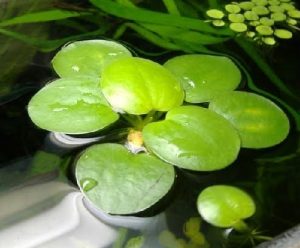
Frogsbit spreads moderately by producing offsets. This floater has shiny light green leaves with sponge-like undersides and long white roots. Light green undersides show slightly for contrast Tiny white flowers appear in July and August. These plants are easy to grow, they float on the surface, so there is no need for soil. They prefer full sun to partial shade.
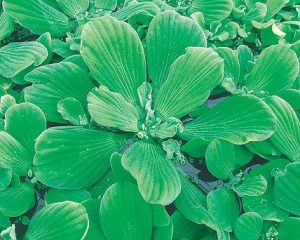
The Water Lettuce plant has pale, dusty green leaves that resemble the leaves of cabbage. This pond plant spreads quickly by producing subsets. It is excellent as a shade plant, but must be controlled. The roots can get up to 9" in length, which helps with the absorption of nitrates, helping to keep your pond water clear & clean. They prefer full sun to partial shade. The Water Hyacinth is a free-floating perennial plant with broad, thick, glossy ovate leaves and striking light-blue to violet flowers. Very easy to grow, these plants are great for surface coverage and algae control. They also provide vulnerable young fish some protection from predators. They are great coverage plants that spread moderately fast by producing subsets.
The Water Hyacinth is a free-floating perennial plant with broad, thick, glossy ovate leaves and striking light-blue to violet flowers. Very easy to grow, these plants are great for surface coverage and algae control. They also provide vulnerable young fish some protection from predators. They are great coverage plants that spread moderately fast by producing subsets.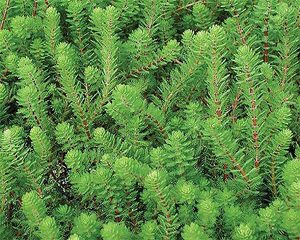 Red Stemmed Parrot's Feather is a very adaptable plant. It has attractive red-stemmed foliage that grows up out of the water with brilliant color contrast; stems are red-blue which can intensify with sun exposure. It is excellent for oxygenating and cleaning the water. It also shades the pond and provides a protective environment for small fish.
Red Stemmed Parrot's Feather is a very adaptable plant. It has attractive red-stemmed foliage that grows up out of the water with brilliant color contrast; stems are red-blue which can intensify with sun exposure. It is excellent for oxygenating and cleaning the water. It also shades the pond and provides a protective environment for small fish.
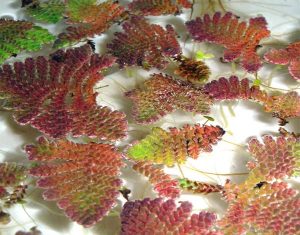 Fairy Moss is an attractive floating fern with a tiny structure about 1/2" across. It is green in the shade, turning deep red with sun exposure. The leaves are covered in fine hairs that give it the appearance of being covered with velvet. It helps provide coverage and shade to help starve out algae. It grows quickly and fish love to eat it.
Fairy Moss is an attractive floating fern with a tiny structure about 1/2" across. It is green in the shade, turning deep red with sun exposure. The leaves are covered in fine hairs that give it the appearance of being covered with velvet. It helps provide coverage and shade to help starve out algae. It grows quickly and fish love to eat it.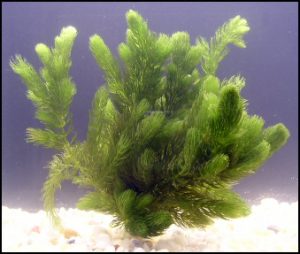 Hornwort is a unique 'oxygenator' in that it does not root; it floats under the surface of the water or at the bottom of the pond. It is bright green and feathery and is an excellent plant that not only provides oxygen to the water, but also acts as a filter. Hornwort combats algae by consuming nutrients in the water and secreting substances that inhibit the growth of algae.
Hornwort is a unique 'oxygenator' in that it does not root; it floats under the surface of the water or at the bottom of the pond. It is bright green and feathery and is an excellent plant that not only provides oxygen to the water, but also acts as a filter. Hornwort combats algae by consuming nutrients in the water and secreting substances that inhibit the growth of algae.
SHOULD I FERTILIZE MY POND PLANTS?
